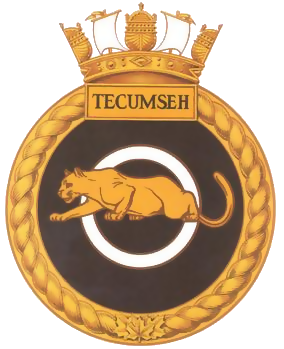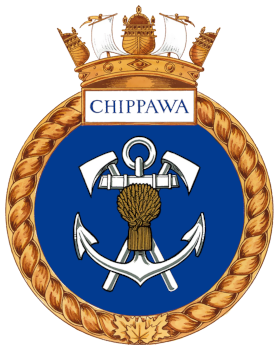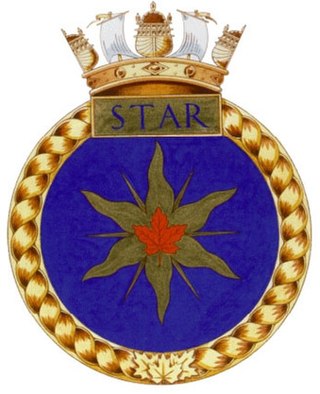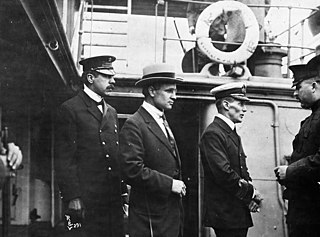
The Royal Canadian Navy is the naval force of Canada. The navy is one of three environmental commands within the Canadian Armed Forces. As of February 2024, the RCN operates 12 Halifax-class frigates, 12 Kingston-class coastal defence vessels, 4 Victoria-class submarines, 4 Harry DeWolf-class offshore patrol vessels, 8 Orca-class patrol vessels, and several auxiliary vessels. The RCN consists of 8,400 Regular Force and 4,100 Primary Reserve sailors, supported by 3,800 civilians. Vice-Admiral Angus Topshee is the commander of the Royal Canadian Navy and chief of the Naval Staff.
The history of the Royal Canadian Navy goes back to 1910, when the naval force was created as the Naval Service of Canada and renamed a year later by King George V. The Royal Canadian Navy (RCN) is one of the three environmental commands of the Canadian Forces. Over the course of its history, the RCN has played a role in the First World War, contributed significantly to the Battle of the Atlantic during the Second World War, and was a part of NATO's force buildup during the Cold War. In 1968, the RCN was amalgamated with the Canadian Army and the Royal Canadian Air Force to form what is today the unified Canadian Armed Forces. The naval force was known as Maritime Command until 2011, when the environmental command was renamed as the Royal Canadian Navy.

Rowland Richard Louis "Rowley" Bourke, was a Canadian farmer, sailor, and a recipient of the Victoria Cross, the highest award for gallantry in the face of the enemy that can be awarded to British and Commonwealth forces.

HMCS Longueuil was a River-class frigate that served in the Royal Canadian Navy during the Second World War. She served primarily as a convoy escort in the Battle of the Atlantic. She was named for Longueuil, Quebec.

HMCS Discovery is a Royal Canadian Navy Reserve division and based in Vancouver, British Columbia, Canada. Created during World War II from the Vancouver Half Company of the Royal Naval Canadian Volunteer Reserve, it was used for recruitment and training, and provided almost 8,000 personnel during the war. It continued its training role after the war, and is also headquarters for several Cadet units.

The Royal Canadian Naval Volunteer Reserve (RCNVR) was a naval reserve force of the Royal Canadian Navy, which replaced the Royal Naval Canadian Volunteer Reserve (RNCVR).

HMCS Tecumseh is a Canadian Forces Naval Reserve division (NRD) located in Calgary, Alberta. Dubbed a stone frigate, HMCS Tecumseh is a land-based naval training establishment crewed by part-time sailors and also serves as a local recruitment centre for the Royal Canadian Navy (RCN). It is one of 24 naval reserve divisions located in major cities across Canada.

The Royal Naval Canadian Volunteer Reserve (RNCVR) was a naval reserve that was established in Canada in May 1914 and existed until 1923. Initially divided into three subdivisions stretching across the nation, the RNCVR could serve either with the Royal Canadian Navy or the Royal Navy during wartime. During the First World War, an Overseas Division was created and by the end of the war, over 8,000 men served either in Canadian service or abroad. Following the war, the reservists were demobilized and Canada's volunteer reserve was reorganized into the Royal Canadian Naval Volunteer Reserve.
His Majesty's Canadian Ship (HMCS) Prevost is a Canadian Forces Naval Reserve Division (NRD) located in London, Ontario. Dubbed a stone frigate, HMCS Prevost is a land-based naval establishment for training part-time sailors as well as functioning as a local recruitment centre for the Royal Canadian Navy (RCN). Prevost reserve sailors serve on all classes of ship on both coasts and the Great Lakes and have served on many occasions overseas on UN and NATO tours of duty, along with harbour defence units.

HMCS Carleton is a Canadian Forces Naval Reserve Division (NRD) located in Ottawa, Ontario, Canada. Dubbed a stone frigate, HMCS Carleton is a land-based naval training establishment crewed by part-time sailors and also serves as a local recruitment centre for the Canadian Forces Naval Reserve. It is one of 24 naval reserve divisions located in major cities across Canada.

HMCS Chippawa is a Royal Canadian Navy Reserve Division (NRD) located in Winnipeg, Manitoba. Dubbed a stone frigate, HMCS Chippawa is a land-based naval establishment for part-time sailors as well as a local recruitment centre for the Royal Canadian Navy (RCN).

HMCS Donnacona is a Royal Canadian Navy reserve division located in Montreal, Quebec. Dubbed a stone frigate, HMCS Donnacona is a land-based naval establishment for training and recruitment primarily of part-time sailors for Canada's naval reserve.

HMCS Star is a Canadian Forces Naval Reserve Division (NRD) located in Hamilton, Ontario. Dubbed a stone frigate, HMCS Star is a land-based naval establishment for training part-time sailors as well as functioning as a local recruitment centre for the Royal Canadian Navy (RCN). The second oldest of 24 naval reserve divisions located in major cities across Canada, Star was stood up on 15 March 1923 as the Royal Canadian Naval Volunteer Reserve (RCNVR) Hamilton Half Company and then on 1 November 1941 as HMCS Star.

The Naval Reserve is the Primary Reserve component of the Royal Canadian Navy (RCN). The primary mission of the NAVRES is to force generate sailors and teams for Canadian Armed Forces (CAF) operations, including: domestic safety operations as well as security and defence missions, while at the same time supporting the Navy's efforts in connecting with Canadians through the maintenance of a broad national presence.

HMCS Unicorn is a Canadian Forces Naval Reserve division (NRD) in Saskatoon, Saskatchewan. Dubbed a stone frigate, Unicorn is a land-based naval training establishment crewed by part-time sailors and also serves as a local recruitment centre for the Royal Canadian Navy (RCN). It is one of 24 naval reserve divisions in major cities across Canada.

Rear-Admiral Walter Hose, was an officer of the Royal Navy (RN), the Royal Canadian Navy (RCN) and founder of the Royal Canadian Naval Volunteer Reserve (RCNVR). Along with Admiral Sir Charles Kingsmill, Hose is known as the "Father of the Royal Canadian Navy".

HMCS Hunter is a Canadian Forces Naval Reserve Division (NRD) located in Windsor, Ontario. Dubbed a stone frigate, HMCS Hunter is a land-based naval training establishment crewed by part-time sailors and also serves as a local recruitment centre for the Canadian Forces Naval Reserve. It is one of 24 naval reserve divisions located in major cities across Canada.

HMCS Brunswicker is a Canadian Forces Naval Reserve Division (NRD) located in Saint John, New Brunswick. Dubbed a stone frigate, HMCS Brunswicker is a land-based naval training establishment crewed by part-time sailors and also serves as a local recruitment centre for the Canadian Forces Naval Reserve and the Royal Canadian Navy (RCN). It is one of 24 naval reserve divisions located in major cities across Canada.
HMCS Griffon is a Royal Canadian Naval Reserve Division (NRD) located in Thunder Bay, Ontario. Dubbed a stone frigate, HMCS Griffon is a land-based naval establishment for part-time sailors as well as a local recruitment centre for the Royal Canadian Naval Reserve. It is one of Royal Canadian Naval Reserve divisions 24 naval reserve divisions located in major cities across Canada.
HMCS Queen Charlotte is a Canadian Forces Naval Reserve Division (NRD) located in Charlottetown, Prince Edward Island. Dubbed a stone frigate, HMCS Queen Charlotte is a land-based naval training establishment crewed by part-time sailors and also serves as a local recruitment centre for the Royal Canadian Navy (RCN). It is one of 24 naval reserve divisions located in major cities across Canada.
















